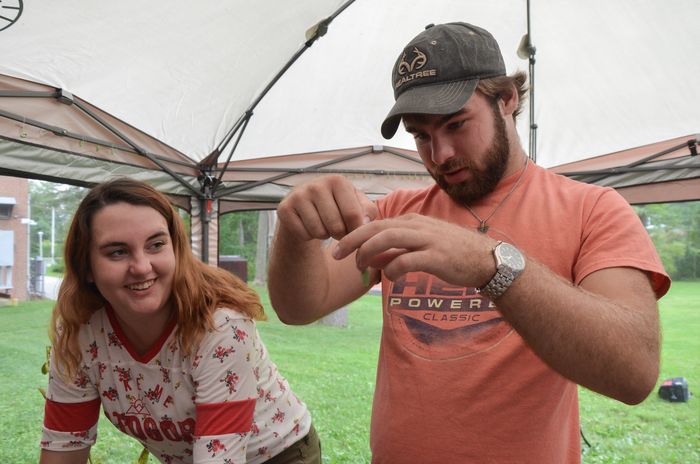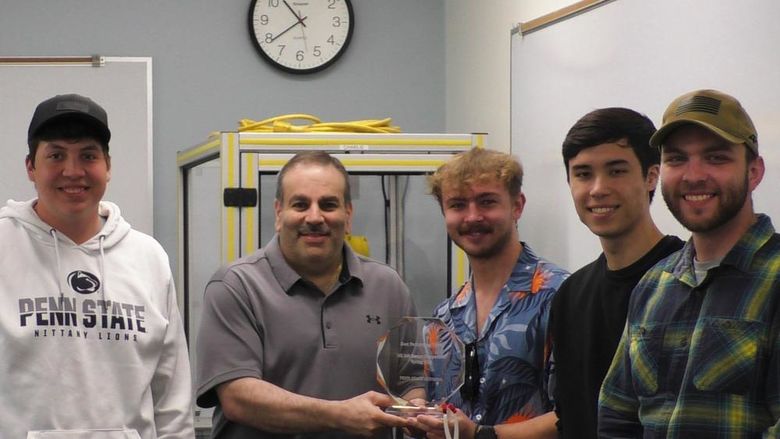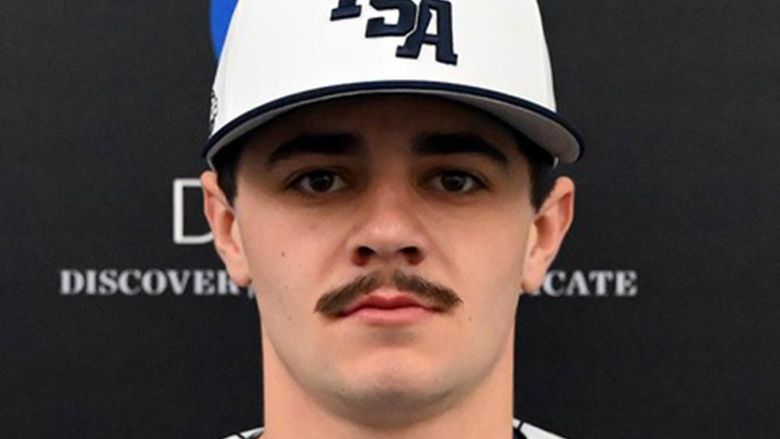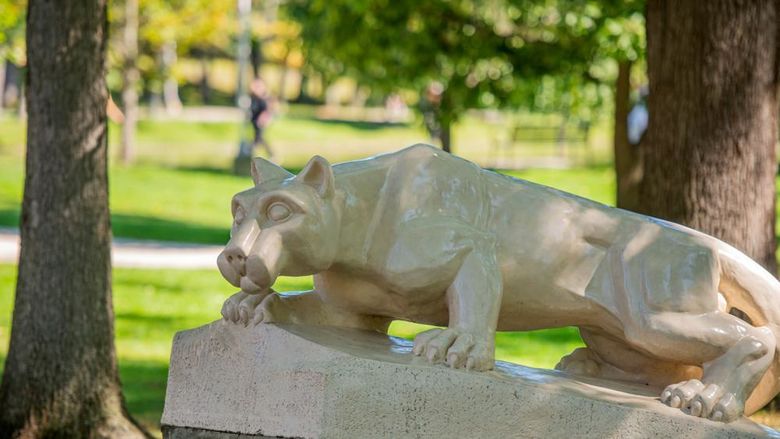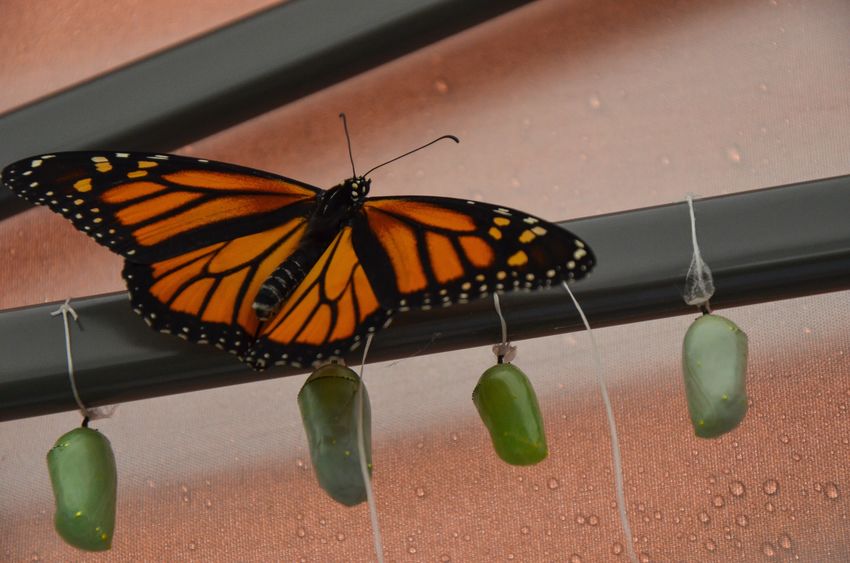
A monarch butterfly rests above several chrysalises waiting to metamorphosize.
Every fall, hundreds of millions of monarch butterflies make their way from the United States and Canada to overwintering sites in Mexico. In recent years, this phenomenal migration is threatened by habitat loss in North America and at their overwintering grounds, so people across the continent have been setting up monarch way stations to help protect this species.
Last fall, Carolyn Mahan, professor of biology and environmental studies at Penn State Altoona, took students in her Ecology of the Mid-Atlantic course to Penn State DuBois to explore one such station created there in 2015. Led by Senior Instructor in Wildlife Technology Keely Roen, the station at Penn State DuBios is modeled after Monarch Watch, established at the University of Kansas in 1992. Monarch Watch is a conservation research program that focuses on the monarch butterfly and how to protect its migration.
Roen explains that several years ago the situation for monarchs looked dire. Eastern monarch numbers had declined approximately 90 percent in just two decades. The overwintering population in Mexico, which pretty much contains every monarch from the eastern United States and Canada, covered only about 1.7 acres during the winter of 2013. "We are losing monarchs because of destruction of their winter habitat in Mexico and the loss of milkweed in the U.S. It could also be the overuse of herbicides and insecticides and extreme weather from climate change. The good news is there are many efforts going on to restore and plant milkweed and nectar plants for the adults. More and more people are starting to plant these in their gardens and raise monarchs. Last winter the eastern monarch population covered over six acres and this summer had one of the most impressive migrations I have seen in a decade. I am cautiously optimistic that these efforts may be making a difference."
Now, some Penn State Altoona students are doing their part to contribute. After visiting Penn State DuBois, Traci Cobb Irvin, a 2017 biology graduate, initiated a rearing program at Altoona and registered the Penn State Altoona campus with Monarch Watch. This year, current environmental studies students Michelle Smithbauer and Nathan White have continued Cobb Irvin’s work. A small Student Engagement Network grant helps pay for supplies such as jars and string, but Smithbauer and White collect milkweed and care for the caterpillars and butterflies on their own time.
Over the summer, Smithbauer collected eggs and caterpillars from the milkweed on which they feed, placed them in jars and and cared for them. About a week before classes started Smithbauer and White erected a tent behind the Holtzinger building and transported the eggs and caterpillars inside. “We feed them and watch them through their growing phases,” said Smithbauer. “They grow to about two inches as caterpillars, make the shape of a J, and weave a chrysalis around themselves.” The pair then tie strings to those chrysalises, hang them around the edge of the tent, and wait for the butterflies to emerge.
“It’s been so interesting learning about their life cycle, from egg to caterpillar to butterfly,” said White. “I’m absolutely loving being a part of this project. It’s really cool.”
Once the butterflies hatch, Smithbauer and White tag one wing with a small sticker labeled with an email address and where the butterfly was raised, then set them free. It is hoped that the butterflies reach the overwintering site in Mexico and these labels will permit them to be tracked by Monarch Watch. So far, more than 30 butterflies have been released from Penn State Altoona. “It’s a lot of work every day, but I really enjoy it,” stated Smithbauer. “They are cool little guys, and they’re fun to take care of. I like watching their process, and it’s so exciting to see them hatch into butterflies.”
Smithbauer says she also enjoys explaining to other students what she and White are doing. “Sometimes as an environmentalist, I can get kind of cynical because I think that nobody cares about nature and the environment. But students are asking questions and getting excited about coming in to see us tag, or they ask how they can take part. It gives them some real-world experience and shows them butterflies aren’t just these mystical things in children’s books. They’re real, and some of them are in trouble.”
For White, the tagging process is his favorite part. “It’s a neat thing to do, and I like watching them fly away, wondering where they will end up. I like things like this more than a class. As an environmental studies major, I prefer doing things that are hands-on, and it’s nice to do something that’s making a difference.”
Smithbauer and White will have released about 50 butterflies by mid-October. They plan to continue the project and hope others are inspired to take part. “The interest in it is really growing and I want everyone to be able to experience it,” said Smithbauer. “I’m happy to have this opportunity. The fact that someday someone will be recording tags and could have a butterfly that was tagged here is crazy. It’s humbling when I think of the big picture.”
If you are interested in getting involved on campus, email Carolyn Mahan at [email protected]. If you’d like to create your own way station, check out monarchwatch.org for information to help you get started.
